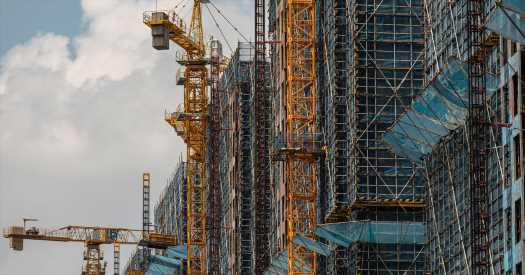How China Made Its Housing Crisis Worse
In China the pension akin to Social Security in the United States pays about $410 a month to seniors who live in cities, and only $25 a month in the countryside. Public health care covers less than half of people’s costs. Unemployment insurance provides around $220 a month; the U.S. average is nearly $1,700.
China’s consumer safety net is full of holes, even when accounting for lower costs of living compared to the United States. As growth has faltered in recent years, and now as a simmering real estate crisis ripples through the economy, China is seeing the consequences of its failure to establish robust social assistance programs.
Beijing policymakers, who have a longstanding aversion to financial protections for households, have begun trimming social spending this year. That could further harm the country’s already sputtering levels of consumer spending, in turn dragging property prices even lower. Real estate and consumer troubles are also exacerbating dangers posed by very high debt among businesses, households and local governments.
Beijing has long been urged by prominent economists, around the world and inside the country, to do more to support its consumer economy, and to stop relying on growth built on speculative construction of apartment towers and heavy public investment in infrastructure like roads and high-speed rail lines. The World Bank and a Chinese government planning agency boldly made the point in 2012 with a report, titled “China 2030,” that called for China to support consumers better and embrace a “turning point in its development path.”
Since then China has mostly doubled down on investments to generate growth. The biggest industry by far over the last several years has been building new apartments — not consumer-oriented services like travel or restaurant dining.
The result is a glut of new apartments that could cripple the economy. China has accumulated enough empty apartments to meet seven years’ worth of demand.
The threadbare social safety net has contributed to the glut of apartments, as families kept buying extra homes as investments they could sell in case of hard times.
The Covid pandemic magnified the problem. Consumer confidence plummeted across China last year during the two-month “Covid zero” lockdown of Shanghai, when even many of the country’s most affluent citizens had trouble obtaining food. Costly mass testing and quarantines left local governments with little money, contributing to a new stinginess this year in social policies, as well as cuts in civil servants’ pay.
China expanded the number of people covered by unemployment insurance during the pandemic from less than half the country’s urban population to many migrant workers who never previously had such coverage. But the expanded coverage expired at the end of last year and has not been renewed even as unemployment has surged, especially among the young.
Many local governments have also been cutting residents’ health benefits this year after anti-Covid measures depleted municipal health insurance funds in 2022. Health coverage reductions have triggered street protests in cities like Wuhan, Guangzhou and Dalian.
Faced with a rapidly aging society and a national pension fund that is expected to run out of money by 2035, the central government has also cut back on increases in payments to seniors. Modest social security allotments had been going up 10 percent a year as recently as 2015. This year’s adjustment was only 3.8 percent and it was delayed from the start of January until May.
In 2020, China delivered on a vow by Xi Jinping, the top leader, to eradicate extreme poverty in rural areas. But the government has not yet worked out detailed goals for the so-called rural revitalization plan that officially started in 2021.
Soon after Mr. Xi took office in 2013, China began economizing on social benefits. Eligibility for the country’s welfare program, which pays just $70 a month in cities and half that in rural areas, was restricted six years ago. It now covers only very old or severely disabled residents who can prove that they cannot possibly find work.
Mr. Xi is a strong critic of public assistance programs, warning in a speech to an elite Communist Party gathering two years ago that China “must not aim too high or go overboard with social security, and steer clear of the idleness-breeding trap of welfarism.”
China had previously made strides toward expanding its benefits as its economy grew swiftly. Welfare spending has grown tenfold since 2000. Few had health insurance two decades ago, now almost everyone does. But while coverage tends to be quite good for victims of car crashes and ailments that mainly affect young, able-bodied workers, they cover little of the cost for serious illnesses that mainly affect seniors, like cancer.
Social safety net “problems are not at all new and cannot be blamed for China’s current economic woes,” said Mary Gallagher, the director of the International Institute at the University of Michigan. “But the weak safety net does explain why Chinese households save for the future and why it has been difficult for the government to boost household consumption as a new source of growth.”
China’s social assistance programs are not only frugal. They are also paid for by the workers who participate in them and to some extent their employers, instead of being subsidized by general tax revenues, as is typical in the West, especially Europe. The monthly payments required to join government pension and health care plans are often beyond the reach of lower-income workers.
Guo Baoyang is a migrant worker who does apartment renovations in Shanghai but is now finding less and less demand for his services. He said that he decided not to pay the $400 a month it would cost him to participate in the municipal pension and medical insurance plans. With the end of the pandemic, unemployment insurance is also no longer available for him.
Mr. Guo said his income has plunged as he works at most 20 days a month. The municipal pension plan “is of no use to us for the time being, we can only receive some after retirement,” he said. “Whether you can survive until then is a question.”
Economic growth in China started to slow before the pandemic and has since slackened further. That has left social spending increasingly in competition with the military budget, which has been expanding 7 percent a year. The Australian government’s defense review in April concluded that China’s current military buildup “is now the largest and most ambitious of any country” since the end of World War II, as China seeks to assert itself as a global power.
Without robust financial support for consumers, China relies on the fact that it offers widespread access to farmland for subsistence agriculture. While nearly two-thirds of China’s citizens live in cities, many people have family members in the countryside. During the national lockdown in early 2020, many workers returned to ancestral villages like Changmingzhen in Guizhou Province and planted gardens to feed themselves.
Assistance is unlikely to expand much soon, said Xian Huang, a Rutgers University professor specializing in Chinese social policy. “For the middle-aged and young people,” she said, “the government’s idea is that they can always find a job, or at least they should try to find a job, therefore they can be self-reliant.”
Li You contributed research.
Keith Bradsher is the Beijing bureau chief for The Times. He previously served as bureau chief in Shanghai, Hong Kong and Detroit and as a Washington correspondent. He has lived and reported in mainland China through the pandemic. More about Keith Bradsher
Source: Read Full Article


